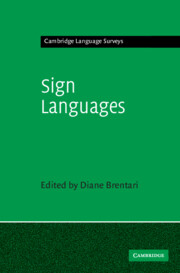Book contents
- Frontmatter
- Contents
- List of figures
- List of tables
- List of contributors
- List of sign language abbreviations
- Notational conventions
- 1 Introduction
- I HISTORY AND TRANSMISSION
- II SHARED CROSSLINGUISTIC CHARACTERISTICS
- III VARIATION AND CHANGE
- 18 Sign languages in West Africa
- 19 Sign languages in the Arab world
- 20 Variation in American Sign Language
- 21 Sociolinguistic variation in British, Australian and New Zealand Sign Languages
- 22 Variation in East Asian sign language structures
- 23 Crosslinguistic variation in prosodic cues
- 24 Deixis in an emerging sign language
- 25 The grammar of space in two new sign languages
- Notes
- References
- Index
23 - Crosslinguistic variation in prosodic cues
from III - VARIATION AND CHANGE
Published online by Cambridge University Press: 05 June 2012
- Frontmatter
- Contents
- List of figures
- List of tables
- List of contributors
- List of sign language abbreviations
- Notational conventions
- 1 Introduction
- I HISTORY AND TRANSMISSION
- II SHARED CROSSLINGUISTIC CHARACTERISTICS
- III VARIATION AND CHANGE
- 18 Sign languages in West Africa
- 19 Sign languages in the Arab world
- 20 Variation in American Sign Language
- 21 Sociolinguistic variation in British, Australian and New Zealand Sign Languages
- 22 Variation in East Asian sign language structures
- 23 Crosslinguistic variation in prosodic cues
- 24 Deixis in an emerging sign language
- 25 The grammar of space in two new sign languages
- Notes
- References
- Index
Summary
Introduction
Sign languages share a common inventory of properties that are used to mark prosodic constituents (e.g., nonmanuals of the face or properties of movement and rhythm; see Quer and Pfau, this volume). This chapter investigates whether there is crosslinguistic variation in the use of one prosodic cue – eye blinks – to mark prosodic constituents in sign languages. We will compare the prosodic use of blinks across four sign languages – Hong Kong Sign Language (HKSL), Japanese Sign Language (JSL), Swiss German Sign Language (DSGS) and American Sign Language (ASL). In the last fifteen years there has been significant work done in sign language phonology with regard to prosodic structure. Miller (1996), Wilbur (1994a), Boyes Braem (1999), Wilbur and Patschke (1999), Nespor and Sandler (1999), Sandler (1999a, 1999b), Brentari and Crossley (2002), Sandler and Lillo-Martin (2006) and Eccarius and Brentari (2007) have worked on various prosodic constituents, including the Intonational Phrase, the Phonological Phrase and the Prosodic Word (also called “Phonological Word” in Nespor & Vogel 1986). The studies presented here are built upon these earlier analyses, expanding our knowledge of crosslinguistic variation of the blinks.
The following research questions are addressed in this chapter. First, how much variation exists among sign languages in their use of a prosodic cue, such as blinks? Second, if crosslinguistic variation exists, what factors condition it? Third, are blinks always associated with intonational phrases crosslinguistically?
- Type
- Chapter
- Information
- Sign Languages , pp. 519 - 542Publisher: Cambridge University PressPrint publication year: 2010
- 10
- Cited by

